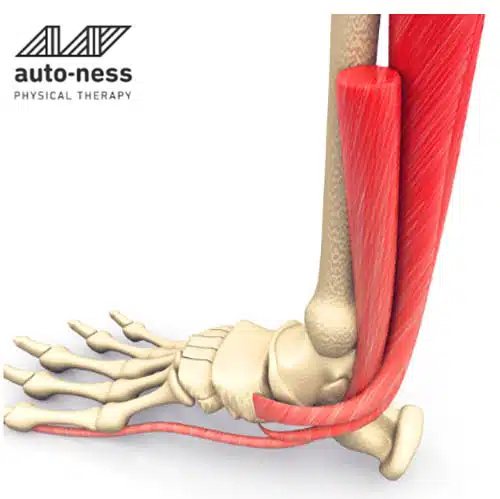Posterior Tibial Tendonitis is a condition that predominantly affects runners and active individuals. It involves inflammation or tearing of the posterior tibial tendon, which connects the calf muscle to the bones on the inside of the foot. It plays a vital role in supporting the arch and assisting in foot movement. This condition can cause pain, swelling, and potentially lead to flatfoot if left untreated.

The Indispensable Role of Physical Therapy
Physical therapy plays an indispensable role in the successful treatment and management of Posterior Tibial Tendonitis. Tailored exercises, as part of a rehabilitation program, help strengthen the tendon and the surrounding muscles, reducing pain and improving function. A skilled physical therapist can design an individualized treatment plan to facilitate effective healing.
Is Physical Therapy Essential in Treating Posterior Tibial Tendonitis?
Auto-Ness Physical Therapy
You might wonder if skipping professional therapy and doing exercises at home will suffice. The simple answer is no. Physical therapy is not only recommended but essential in treating this condition. A physical therapist ensures you are performing exercises correctly, monitors your progress, and modifies your treatment plan according to your specific needs.
Early Intervention: Nip it in the Bud
During the initial phase of the condition, the primary objective is to reduce inflammation and alleviate pain. The physical therapist often recommends rest, ice application, and certain exercises to relieve pain and initiate the healing process. People often search for “PT near me” to find immediate and effective care.
Gaining Strength and Flexibility: The Core of Recovery
The next step is targeted exercises to restore strength and flexibility to the affected area. This involves a variety of exercises like calf stretches, toe raises, and foot inversion and eversion exercises. A balanced program will include both weight-bearing and non-weight-bearing activities to prevent additional strain on the tendon.
Pain Management: No Gain, Less Pain
Pain is a constant companion with Posterior Tibial Tendonitis. Physical therapy can significantly assist in managing and reducing this discomfort through methods like progressive-resistive exercise, heat application, and manual therapy techniques.

Preventing Future Episodes
One of the long-term goals of physical therapy is to prevent the recurrence of Posterior Tibial Tendonitis. By educating patients on proper running techniques, footwear, and other preventive measures, physical therapy plays a crucial role in reducing the likelihood of future episodes.
Take the First Stride to a Pain-Free Run
Posterior Tibial Tendonitis shouldn’t stop you from enjoying the sports and activities you love. Early intervention, especially with the help of a trained physical therapist, can make all the difference in your recovery journey.
Your Next Step Towards Recovery with Auto-Ness Physical Therapy
If you or a loved one are struggling with Posterior Tibial Tendonitis, don’t wait for the problem to escalate. At Auto-Ness Physical Therapy, our team of highly skilled professionals specializes in sports medicine and physical therapy. We are committed to providing personalized treatment plans tailored to meet your unique needs, enabling you to get back on your feet, literally.
Contact us today to schedule an appointment and take the first step towards a pain-free, active life. With Auto-Ness Physical Therapy, you’re not just receiving care; you’re gaining a lifelong partner in your health journey.
Frequently Asked Questions (FAQs)
What is Posterior Tibial Tendonitis?
Posterior Tibial Tendonitis is an inflammation or tear of the posterior tibial tendon, which connects the calf muscle to the bones on the inside of the foot. It is particularly common among runners and active individuals.
How is Posterior Tibial Tendonitis Diagnosed?
The condition is typically diagnosed through a clinical evaluation, which may include an examination of your foot, gait analysis, and imaging tests like X-rays or MRIs to confirm the diagnosis.
Is Physical Therapy Necessary for Posterior Tibial Tendonitis?
Yes, physical therapy is a critical component for effectively treating Posterior Tibial Tendonitis. A physical therapist will provide an individualized treatment plan that includes exercises designed to strengthen the affected area and improve its function.
Can I Treat Posterior Tibial Tendonitis at Home?
While home exercises may provide some relief, it’s essential to consult a trained physical therapist for a proper diagnosis and treatment plan. At Auto-Ness Physical Therapy, our professionals can help you on your road to recovery with personalized treatment plans.
What Types of Exercises Are Included in Physical Therapy for Posterior Tibial Tendonitis?
Physical therapy for Posterior Tibial Tendonitis often involves a variety of exercises like calf stretches, toe raises, and foot inversion and eversion exercises. Both weight-bearing and non-weight-bearing exercises are usually included in the treatment plan.
What Can Happen if Posterior Tibial Tendonitis is Left Untreated?
If untreated, this condition could lead to worsening pain, increased inflammation, and ultimately flatfoot, which may require more invasive treatments.
What Are Some Prevention Measures for Posterior Tibial Tendonitis?
Prevention measures include wearing proper footwear, incorporating foot and ankle strengthening exercises into your routine, and seeking early intervention and proper treatment when symptoms first appear.
How Can Auto-Ness Physical Therapy Help Me?
At Auto-Ness Physical Therapy, we offer specialized treatment plans tailored to your unique needs. Our highly skilled team will guide you through the recovery process, from pain management to regaining strength and preventing future episodes of Posterior Tibial Tendonitis.


